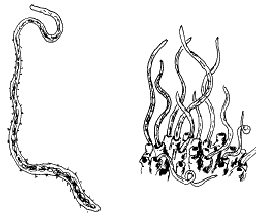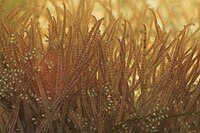Tubifex tubifex
| Tubifex tubifex | ||||||||||||
|---|---|---|---|---|---|---|---|---|---|---|---|---|

Tubifex tubifex |
||||||||||||
| Systematics | ||||||||||||
|
||||||||||||
| Scientific name | ||||||||||||
| Tubifex tubifex | ||||||||||||
| ( Müller , 1774) |
Tubifex tubifex (Latin from tubus "tube" and -fex "-macher"), German common sludge tube worm or common brook tube worm, is the longest known species of the genus Tubifex . Thus one of the aquatic annelids . Colloquially and in the aquarium hobby, Tubifex is often referred to simply , whereby either the species Tubifex tubifex or (mostly) some species of the genus Tubifex is meant. In fact, the animals on the market often belong to different Tubifex species.
External features
Tubifex tubifex is a thin, reddish worm about 2.5 to 9 cm long. Its color is due to the hemoglobin-containing body fluid that is transported within the blood vessel system. Tubifex species are now found all over the world.
Way of life
Tubifex tubifex and its related species normally live in the mud of standing and flowing, even heavily polluted waters and form mud tubes lined with slime. The worm is stuck with the head part up to half in the bottom of the water, since the oxygen uptake takes place via the rectum ( intestinal breath ). Oxygen is brought in through the winding movements, but they can survive for up to 48 hours even without oxygen, whereby they gain the necessary energy by means of glycolysis . Tubifex feeds mainly on detritus and other organic decomposition substances. Due to its hemoglobin -rich blood, which is responsible for the red color, the worm can also live in oxygen-poor waters.
In the context of the water quality assessment , the species is considered a bio-indicator for the heavy pollution of a water body with organic substances.
Use in the aquarium hobby
Tubifex tubifex and its related species are used by aquarists as live fish feed and are available from specialist pet shops. Since it has been proven that living Tubifex species can transmit pathogens ( Myxobolus cerebralis and Myxobolus cotti from the Myxozoa group ), many aquarists only feed these in frozen or freeze-dried versions.
Use in ecotoxicology
Tubifex tubifex is occasionally used as an ecotoxicological test organism for testing the toxic components of water sediments. The animals are considered to be relatively robust against harmful effects, but are nevertheless suitable test organisms: When exposed to high levels of stress, they tend to avoid the sediment and tend to autotomy (self-division of the individuals by separating segments). At significantly lower concentrations, the worm reduces its burial activity; this can be used as a sensitive indicator of the toxic effect of the sediment.
Individual evidence
- ↑ M. Meller, P. Egeler, J. Römbke, H. Schallnass, R. Nagel, B. Streit: Short-term toxicity of lindane, hexachlorobenzene, and copper sulfate to tubificid sludgeworms (Oligochaeta) in artificial media. In: Ecotoxicology and Environmental Safety . 39, 1998, pp. 10-20.
Web links
swell
- Gunter Steinbach (ed.), Heiko Bellmann: Life in brook and pond: Plants and invertebrates of the small water bodies. (= Orbis nature guide ). Orbis-Verlag, 2000, ISBN 3-572-01085-3 .
- B. Wax: The most common hemoglobin-carrying oligochaetes in Central European inland waters. In: Hydrobiologia. Volume 30, No. 2, September 1967, pp. 225-247. (Abstract)
- RO Brinkhurst, BM Jamieson: Aquatic Oligochaeta of the world. Oliver & Boyd Publishing House, Edinburgh 1971.
- Heinz Streble , Dieter Krauter : Life in a drop of water. Microflora and microfauna of freshwater. An identification book. 9th, revised and expanded edition. Kosmos, Stuttgart 2002, ISBN 3-440-08431-0 .
- Wolfgang Engelhardt: What lives in pools, brooks and ponds? Plants and animals in our waters. Kosmos, Stuttgart 2003, ISBN 3-440-09800-1 .
